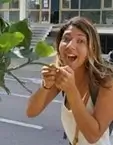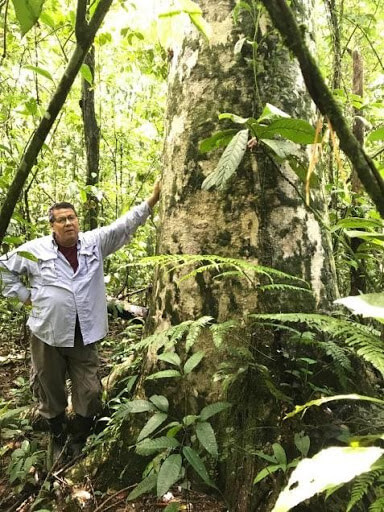Featured Data
Growth and Survival of Seedlings of 14 Species of Lowland Rainforest Trees Planted in the La Guaria Annex of La Selva Biological Station, Costa Rica, in 1986
May 1, 2021
Susanne Grossman-Clarke
Citation
Johnson, C.E., M. Salva Sauri, E. Gonzalez, O. Vargas Ramirez, D.K. McClearn, E. Braker, E. Castro, and A. Sepulveda. 2021. Growth and survival of seedlings of 14 species of lowland rainforest trees planted in the La Guaria Annex (Canada Plot) of La Selva Biological Station, Costa Rica, in 1986 and measured every six months or every year until 1992 (Part 1 of 2) ver 1. Environmental Data Initiative. https://doi.org/10.6073/pasta/8910223d4e871fe915d992b7d729c14b.
M. Salva Sauri, E.C. Johnson, E. Gonzalez, O. Vargas Ramirez, D.K. McClearn, E. Braker, E. Castro, and A. Sepulveda. 2021. Growth and survival of seedlings of 14 species of lowland rainforest trees planted in the La Guaria Annex (Canada Plot) of La Selva Biological Station, Costa Rica, in 1986 and measured every six months or every year until 1992 (Part 2 of 2) ver 1. Environmental Data Initiative. https://doi.org/10.6073/pasta/9c12c65c7138d7c26b5f35140a42d6cf.
Description

The Organization for Tropical Studies (OTS) based in Costa Rica, is currently undertaking a robust and concerted effort to identify, retrieve, manage, and share important legacy data sets from tropical research projects going back to the 1960s. The salient aspects of this project include: 1) locating the relevant data and metadata artifacts (photos, maps, field notes, technical reports), 2) securing the data in the EDI repository, 3) publishing and sharing the data within the scientific community, and 4) creatively repurposing the data and projects for future research efforts.
The data packages featured here relate to the Legacy Data Project, an ambitious undertaking by OTS to facilitate the proper management and availability of data from projects of OTS and investigators working at OTS research stations over the past several decades. Many of the OTS projects of this nature were associated with the establishment of tree plots to investigate issues such as tropical forest structure, growth of native tree species under different conditions, and interactions of crop species with native tree species.

The lead authors of the data packages, Melissa Salva Sauri and Eric Johnson, were EDI Summer Fellows in 2020 with OTS’ La Selva Biological Station. Melissa is currently the research manager of the Luquillo Long-Term Ecological Research Site in Puerto Rico. Eric is a Ph.D. student at Indiana University in Biological Anthropology. During the fellowship program and beyond, Melissa and Eric digitized this information, cleaned the data, and prepared them in an archive-ready format. Sufficient metadata were compiled before publishing the data packages to explain the data for reuse by other researchers.

Specifically, the two data packages focus on the rescue of historically and economically important data from native tree growth studies established in 1985 and known as the TRIALS project at the La Selva Biological Station in the Caribbean lowlands of Costa Rica. The TRIALS project (starting with the CANADA Plot) was designed by OTS and the DGF (Dirección General Forestal) to measure the growth and survival of native tree seedlings planted on abandoned pasture lands at the La Selva Biological Station.

Over a period of five years (1985 – 1990) seedlings of different local native tree species were planted in numerous mixed plots of approximately 49 individuals each (7X7) with a spacing of 2.5 or 3.0 meters at the Caribbean lowland site of La Selva Biological Station. Seeds were collected and germinated at La Selva and thus represent local genetic stock. Data on survivorship and growth were collected every six months for three years. Based on these data, a short list of 13-15 species was produced that formed the basis of government recommendations for reforestation, timber plantations, and Costa Rica’s landmark Payment for Environmental Services program. Most of these trees have not been measured for the past 25 – 30 years but are still identifiable from detailed maps of the plots that were created at the time of planting.

Historical Background
During the 1960s, 1970s, and 1980s, Costa Rica’s old growth forests were being cut to clear land for cattle pastures and large-scale agriculture. Costa Rica also had active and profitable timber concessions but all of the trees grown for harvesting on plantations were non-natives such as pine, eucalyptus, gmelina, and teak.
In order to combat forest loss, the Costa Rican government was developing plans for a reforestation program and established the Payment for Environmental Services (Pago para Servicios Ambientales – PSA) program in 1996. The PSA has completely transformed the way reforestation and forest protection were accomplished in Costa Rica by mandating the use of native trees. PSA payments have provided income for thousands of land-owners in Costa Rica over the past 2+ decades and the model has been exported to many other countries, encouraging reforestation and preservation of forests around the world.
The PSA was largely based on the early TRIALS results and the follow-up studies conducted by EARTH University, CATIE, FUNDECOR, and other Costa Rican forestry and agroforestry organizations.The first TRIALS efforts, started with $10,000 from the Canadian Embassy in 1985, planted 83 native tree species at La Selva and after a few years of growth determined that 13-15 of them grew fast enough in abandoned pastures to be considered as plantation trees. Until the TRIALS tree growth data were available, there was no reliable information on how fast tropical trees in Central America grew.
In recent years, some of these TRIALS plots (with tagged trees of many species and known ages) were repurposed for the ECOS study (Dr. Ann E. Russell and Dr. James W. Raich, Iowa State University, PIs). One goal of this project was to determine how much carbon was being sequestered (taken out of the atmosphere) by growing trees every year. This is an important calculation in any effort to offer “carbon credits” to governments or private landowners but until this study there was very little information on carbon sequestration by trees in the lowland tropics. This study has the added advantage that the carbon available in the roots (belowground carbon) was calculated as well as the carbon in the trunks and branches (aboveground carbon). Russell and Raich calculated that it takes roughly 1.4 hectares (3.5 acres) of trees in a secondary tropical forest of about 20 years of age to offset the amount of carbon that the average person in the U.S. consumes each year.